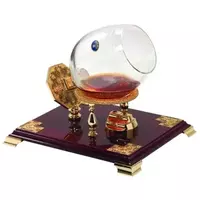Armagnac

The noble name Armagnac strong alcoholic drink from grape alcohol got thanks to the oldest and most famous family of French aristocrats who have long owned the lands of Gasconia. In ancient times, this part of France was called nothing more than the county of Armank.
Armagnac according to the classification of alcoholic beverages refers to brandy. The taste, aroma, color, as well as other consumer qualities of Armagnac are incredibly close to brandy. However, brandy is a more famous and common drink than its French counterpart from sunny Gasconia.
This is primarily due to the location of the Gascon region, which is isolated from access to the sea. Therefore, it was expensive for merchants to deliver an excellent Armagnac drink to other regions of France or abroad. The production of Armagnac, like other noble drinks in France, is strictly regulated by special regulations, many of which come from the Middle Ages.
For example, it is clearly established who has the right to produce Armagnac. In France, there are only three zones (Baza-Armagnac, Tenares and Haute-Armagna) in which a real alcoholic drink Armagnac is produced. True connoisseurs and real foodies know that only that drink can rightfully be called Armagnac, which is produced from special grape varieties.
For the production of Armagnac, not only a unique wine distillation technology is used, but also production devices - Sharant Alambik and Armagnac Alambik. In the production of the drink until our time, firewood from natural oak is used. As a result of distillation of grape braga, alcohol with a strength of 65% is obtained, then the young Armagnac is poured into oak barrels, in which the drink acquires its distinctive taste, color and aroma.
Armagnac is not diluted with water before bottling, as is done in other alcoholic beverages (for example, cognac) to reduce the strength of the initial alcoholic material. Armagnac is divided into species primarily depending on the exposure of the alcoholic beverage. Currently, the following types of Armagnac can be purchased:
Armagnac Blanche, an intemperate white young drink;
Armagnac VS or Armagnac * * * is a drink that has been aged in oak barrels for 3 to 5 years;
Armagnac VO or VSOP, such a drink was aged for 5-6 years;
Armagnac Napoleon or XO aged from 6 years;
Armank Hors d'Age is an expensive drink that has languished in a barrel for at least 10 years;
Armagnac millesimal is distinguished in a separate group, this is the most expensive type of drink, which belongs to special and rare types of drink, therefore it costs an indecent lot of money. Millesim is a concept that denotes a certain year in winemaking, in which there was the best harvest of quality grapes. Therefore, Armagnac of different years and houses can become unique and collectible.
Armagnac 225 kCal
Energy value of Armagnac (Ratio of proteins, fats, carbohydrates - ju):
Proteins: 0.1 g (~ 0 kCal)
Fats: 0.1 g (~ 1 kCal)
Carbohydrates: 0.5 g (~ 2 kCal)
Energy ratio (bj | y): 0% | 0% | 1%
 Español
Español Français
Français Português
Português Русский
Русский 简体中文
简体中文 繁體中文
繁體中文 日本語
日本語 한국어
한국어 العربية
العربية Türkçe
Türkçe Қазақ
Қазақ Deutsch
Deutsch Italiano
Italiano Українська
Українська
